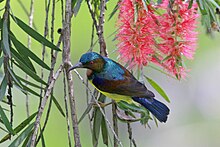Japanese Garden, Singapore
| Japanese Garden | |
|---|---|
 The bridge connecting the Chinese and Japanese Gardens | |
 | |
| Type | Tourist attraction |
| Location | Jurong East, Singapore |
| Area | 135,000 square meters |
| Created | 1974; 50 years ago (1974) |
| Status | Open daily from 5:30am to 7:00pm (SST) |
Japanese Garden (Japanese: 日本庭園) is a park and garden located in Jurong East, Singapore. Built in 1974 by JTC Corporation, it covers 13.5 hectares (135,000 m2) of land.[1][2]
It is built on an artificial island in Jurong Lake and is connected to the adjacent Chinese Garden island by bridge named the Bridge of Double Beauty.[3] Along with the aforementioned Chinese Garden, the two gardens are collectively known as the Jurong Gardens.
Layout and design
Where the Chinese Garden is designed to be visually exciting, the Japanese Gardens are designed with a calmness to evoke inner peace and a meditative state. The styles and methods used for designing the garden are taken from Japan's Muromachi period of 1392 to 1568 and the Azuchi–Momoyama period of 1568 to 1615.[3]

With its traditional arched bridges, 10 odd Tōrō stone lanterns, traditional house and rest house, ponds and gravel chipped pavings[4] it faithfully recreates the traditional Japanese style.
Interests
On the grounds is also a Turtle & Tortoise Museum[5] as well as one of 10 sundials placed around Singapore to promote the interest in science. The one in the Japanese Garden represents the planet Venus (while the one in the Chinese Garden is for 'Earth').[3] Large monitor lizards can be seen roaming in the area of the koi filled ponds.
Cultural festivals such as Chinese New Year (usually January/February) and the Mid-Autumn Festival (September/October) are the best times to visit the gardens.[6]
See also
- Geography of Singapore
- Japan–Singapore relations
References
- ^ "Singapore Chinese and Japanese Gardens". www.jgarden.org/. Archived from the original on 23 January 2013. Retrieved 7 November 2012.
- ^ "Singapore Parks - Singapore Attractions". www.singapore.com/. Retrieved February 24, 2014.
- ^ a b c "Japanese Garden". www.all-about-singapore.com. Archived from the original on 19 April 2018. Retrieved 7 November 2012.
- ^ "Review of Chinese and Japanese Gardens". Frommers. Retrieved 7 November 2012.
- ^ "Lonely Planet review for Chinese & Japanese Gardens". Lonely Planet. Archived from the original on 19 August 2014. Retrieved 17 August 2014.
- ^ "Chinese and Japanese Gardens". Time Out Singapore. Retrieved 2020-04-25.
External links

- Official website of the Jurong Lake Gardens
- v
- t
- e
- Coastal PlayGrove
- Sentosa
- NTUC Downtown East
- Bukit Batok Memorial
- Caldwell House
- CHIJMES Hall
- Civilian War Memorial
- Early Founders Memorial Stone
- Former Indian National Army Monument
- Founders' Memorial
- Japanese Cemetery Park
- Kranji War Memorial
- Lim Bo Seng Memorial
- Old Tao Nan School
- Raffles's Landing Site
- SGH War Memorial
- Tan Kim Seng Fountain
- The Cenotaph
- ArtScience Museum
- Asian Civilisations Museum
- Baba House
- Buddha Tooth Relic Temple and Museum
- Changi Chapel and Museum
- Chinese Heritage Centre
- Former Ford Factory
- Fort Siloso
- Images of Singapore
- Indian Heritage Centre
- Madame Tussauds Singapore
- Malay Heritage Centre
- National Gallery Singapore
- National Museum of Singapore
- Peranakan Museum
- Reflections at Bukit Chandu
- Science Centre Singapore
- Singapore Art Museum
- Singapore Philatelic Museum
- Singapore Discovery Centre
- Sun Yat Sen Nanyang Memorial Hall
- The Battle Box
- Alkaff Gardens
- Beauty World Market
- Big Splash
- CN-West Leisure Park
- Escape Theme Park
- Fantasy Island
- Gay World Amusement Park
- Great World Amusement Park
- Jurong Bird Park
- Malay Village
- New World Amusement Park
- Punggol Zoo
- Singapore Pinacothèque de Paris
- Tang Dynasty City
- The Maritime Experiential Museum
- Ultimate Magic
- Underwater World
- Van Kleef Aquarium
- Volcanoland
- Wonderland Amusement Park
01°20′9.46″N 103°43′50.77″E / 1.3359611°N 103.7307694°E / 1.3359611; 103.7307694
 | This Singapore-related article is a stub. You can help Wikipedia by expanding it. |
- v
- t
- e









